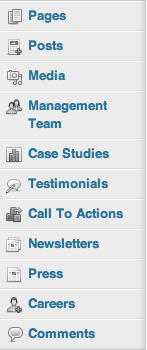Businesses are often surprised by the 12 – 14 week design and development phase to produce a website. It’s difficult to realize a large portion of that time website design agencies spend making customized changes to fit your business needs. Between tweaking header typography to adjusting image resolutions, the time put into the backend saves the client valuable hours after the completed site is handed over. Here are our backend website “must-haves” when creating a customized client site:
 User-friendly content management system. The core of a website is the content management system (CMS) that it runs on. This allows companies to log into the backend to modify copy, upload images, create new subpages, change the navigation, and much more. A clunky, inefficient CMS sucks time and energy when you need to refresh a webpage or solve website problems.
User-friendly content management system. The core of a website is the content management system (CMS) that it runs on. This allows companies to log into the backend to modify copy, upload images, create new subpages, change the navigation, and much more. A clunky, inefficient CMS sucks time and energy when you need to refresh a webpage or solve website problems.
Easy navigation. Do you offer products or services? Do you feature company news or press? Building a backend that reflects these slight differences in wording can save time spent explaining to colleagues where they need to navigate to in order to make changes. Make sure your website developer is using your company lexicon and mapping a backend experience to mirror it.
Flexible calls to action. Most company websites feature calls to action that differentiate them from their competitors. This ranges from rotating homepage images to news tickers to newsletter signups, but the most important factor is the ability to change these modifications if necessary. If your company opts to switch from quarterly newsletters to monthly, the backend should allow the user to easily update that information.
Smooth style sheet implementation. A lot of time and money is put into designing the look and feel of a website. Building a backend to support it is critical. Applying code that automatically updates headings, paragraph text, navigation fonts, and background colors to match the company style sheet ensures the branding is uniform every time content is changed.
Auto-adjusted images. Adding images to a website is always encouraged to create a visually appealing interface. Depending on the page housing the visual, the backend should predetermine upload rules such as image size, justification, text wrap, and quality. Not having fixed attributes leaves the guesswork on the user, resulting in unorganized, irregular, and unprofessional images.
If a website is a living, breathing resource, then the backend is the heart that supports it. With a customized backend to fit your company needs, you’re saving valuable time that would otherwise be spent wrestling website updates. Bop Design clients all receive customized WordPress sites with a seamless content management system. In addition, we offer a helpful WordPress sample backend for current and prospective clients to familiarize themselves with the platform. Contact us today with your website questions and to test-run our WordPress platform.



